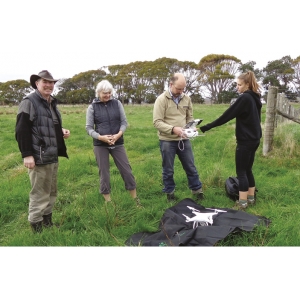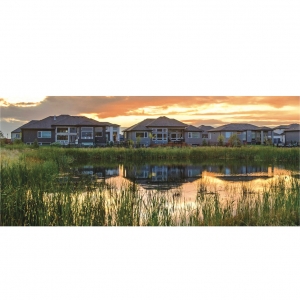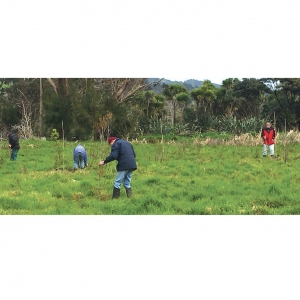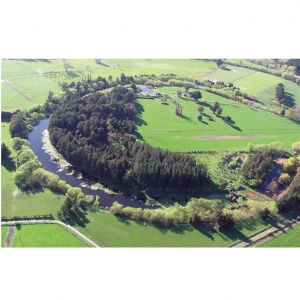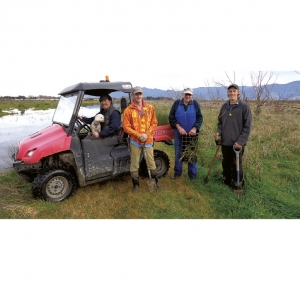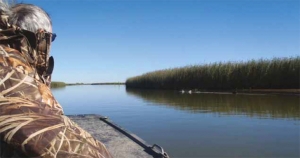Displaying items by tag: Wetlands
Wairio in action
A busy day at Wairio:
There was a digger on site to raise the walking track.
The success of retaining water in the wetland has required this work. Also the need to clear a few culverts to allow the water to flow more easily from Stage 4 (in the slightly higher ground in the north of the wetland) to the Stage 3 area. Though there is still plenty of work in progress and the need to equalise the water level.
There is new walking track signage made by DOC. That will be a big help for those interested in exploring the area.
And lastly, Stephen Hartley from Victoria University (with helpers Maxine, Veronica and our own Ross Cottle) starting a drone flight to record vegetation and water levels, principally in the Stage 3 research area.
What is a wetland
What is a wetland?
A wetland is an area of land whose soil is saturated with moisture either permanently or seasonally.
Such areas may also be covered partially or completely by shallow pools of water
The new green scene
Harnessing wetlands as green infrastructure solutions to our water woes
For one weekend every July in Canada, the village of St. Pierre-Jolys hosts the National Frog Jumping Championship. It’s part of the annual Frog Follies Festival. The thriving Franco-Manitoban community is also proud of its parks, a new residential compost pickup service and the Trans-Canada Trail that runs along the nearby Rat River. It’s about as green as it gets here. And it’s about to get greener.
Seeing wastewater through a green lens
Standing on a grassy berm overlooking St. Pierre-Jolys’ current wastewater treatment lagoon, Janine Wiebe points to an adjacent muddy field.
“In a few months, this field will be full of heavy equipment,” she says, smiling. The village’s chief administrative officer describes how their wastewater treatment system will expand to include a new tertiary treatment wetland.
Like all communities, St. Pierre-Jolys must anticipate the current and future needs of their wastewater treatment system. Future growth depends on it. Their system needs to remove pollutants, deliver clean water, handle increased volume and cope with the uncertain timing of storm water events.
Traditional, concrete treatment plants are expensive to build and maintain. St. PierreJolys found a better solution.
Staff from Native Plant Solutions (NPS) proposed the tertiary treatment wetland; a sustainable, cleaner, cost-effective and greener way to reduce nutrient levels in the village’s wastewater.
“In this system, a third cleansing cell – the wetland – is added to the primary and secondary treatment cells to reduce phosphorous levels,” says Glen Koblun, manager of NPS. NPS is a consulting branch of Ducks Unlimited Canada (DUC) and a leader in science-based treatment wetland systems.
“There’s lower maintenance and management costs to this system compared to chemical or mechanical treatment options,” adds Koblun.
The treatment wetland system takes advantage of the natural functions of wetland plants – a process called phytoremediation – that transforms common pollutants into harmless by-products or essential nutrients. This comes from the sheer amount of biological activity that occurs in a wetland system including sunlight, wind, water, air, plants and soils.
“This project fits our vision,” says Wiebe. “We are leaving a legacy that will make it easier for future generations. It allows room for expansion and will cost less in the long run.”
Green infrastructure: it’s only natural
Green infrastructure is a buzz word that’s infiltrating conversations about making communities more resilient to disasters like floods. DUC research scientist Pascal Badiou, PhD, believes green infrastructure is essential. Wetlands, he says, are one of the most powerful systems available to us.
Traditional built infrastructure such as dry dams or water treatment systems serve an important role but typically address only one issue and come with high maintenance costs,” says Badiou.
“Green infrastructure, which includes natural areas, vegetation and wetlands, captures and treats stormwater and runoff at its source. It’s building with nature instead of concrete.”
Communities from coast to coast are finding that nature has an effective and efficient way to deal with wastewater: wetlands. These cost-effective, natural powerhouses provide benefits and services that reduce the need for costly built (grey) infrastructure such as dams, water diversions, water treatment plants and engineered carbon sinks. Green infrastructure like wetlands can also reduce pressure on and extend the life of grey infrastructure. ©DUC
Wetlands hold rainwater, snowmelt and floodwaters. They filter pollutants, store carbon, replenish groundwater, reduce erosion and provide habitat for wildlife as well as places for people to enjoy the outdoors.
“Other types of flood control are not able to deliver the additional benefits that wetlands provide,” says Badiou, who has conducted extensive research across the Prairies about the role of wetland drainage on water quality and quantity.
Seeing the green light through restoration
Getting people and governments to appreciate green infrastructure can be difficult. In Alberta, it took the devastating floods of June 2013 for the provincial government to reach a watershed moment. Southern Alberta was inundated. Downtown Calgary shut down. These events cost millions of dollars in damage.
The government responded with a number of funding programmes to address a wide range of recovery activities, including the Watershed Resiliency and Restoration Programme (WRRP). As its name implies, the WRRP aims to improve watershed functions to build greater long-term resiliency to droughts and floods. Resiliency would be improved through restoration, conservation, education and stewardship.
Traditional mitigation projects involve largescale construction or engineered structures (“grey” infrastructure). Watershed restoration supported by WRRP focuses on natural solutions. This includes conserving and restoring wetlands.
Tracy Scott, DUC’s head of industry and government relations in Alberta, and other DUC staff presented a business case for the use of wetland restoration for flood mitigation in southern Alberta. Their efforts helped inform the government’s development and implementation of the WRRP.
“The expansion of the WRRP programme to include natural green infrastructure was an excellent example of how we helped the Government of Alberta align wetland conservation with provincial and societal priorities, including Alberta’s Wetland Policy,” says Scott. “Few people recognise that the new Alberta Wetland Policy represents an important implementation tool to support Alberta’s flood, drought, water quality and biodiversity management goals.”
During the first round of the programme’s implementation in 2014, DUC has received $11.6 million to fund restoration of 1,380 acres (558 hectares) of wetlands in flood- and drought-prone areas in the southern part of the province
“A significant proportion of that money is going directly into the pockets of participating landowners, rewarding them for their contribution to ecosystem services, with the balance being used for the actual restoration work,” says Scott.
This puts the natural power of the landscape to work, instead of relying only on traditional engineered infrastructure,” says Scott. It’s a proactive approach that’s safeguarding the long-term future of water, wildlife and people across the province.
“The WRRP is the first chapter of DUC’s green infrastructure story in Alberta,” says Scott.

St. Pierre-Jolys CAO Janine Wiebe stands near the future site of the village’s tertiary treatment
wetland. The village consulted with DUC’s Native Plant Solutions on the project, will be an
additional treatment step to clean wastewater. This form of green infrastructure uses natural
wetland processes to clean the water before it enters the Rat River. ©Leigh Patterson
Pairing green with grey
As Alberta has learned, flood control is a key environmental benefit provided by wetlands. But little research exists specific to Ontario. The need to fill information gaps has escalated in recent years as the province has been hit with bigger storms and floods.
In 2016, DUC and several partners conducted research in the Credit River watershed, a densely-populated region vulnerable to extensive flooding. They used a hydrological model that quantified the consequences of wetland loss and gain on flooding under a variety of storm events.
This past fall, the results came in.
Not surprisingly, in modeling scenarios where researchers removed wetlands from the landscape, flooding was worse. When wetlands were restored the intensity of flooding diminished.
The research supports the idea that when combined with built infrastructure like storm water retention ponds, green infrastructure like wetlands can provide another layer of flood defence. Green infrastructure like wetlands can also reduce the pressure on and extend the life of grey infrastructure.

“The research identifies areas where wetland restoration will have the greatest impact on flood reduction,” says Mark Gloutney, PhD, DUC’s director of regional operations, eastern region. “DUC can work with municipalities, conservation authorities and others to better plan for extreme weather and flooding by helping build up their inventory of natural infrastructure assets, like wetlands.”
Building climate-resilient communities in Ontario will require strategic investments in wetland restoration, says Gloutney. DUC, he adds, “is prepared to come to the table.”
Coast to coast: more shades of green
Janine Wiebe is looking forward to the final implementation of her village’s green vision. They plan to add educational signage and trails around the new tertiary wetland site. They also want to invite environmental science students to conduct research there.
As they wait, cities like Moncton, N.B. are reaping the rewards of investing in green infrastructure.
By working with NPS staff, Moncton has integrated wetland-like naturalised storm water retention ponds into urban developments. These urban wetlands are able to store and filter vast amounts of water, which improve water quality as a result.
Elaine Aucoin, Moncton’s director of environmental planning and management found that these systems are functional, and add to the quality of life for residents. “Wetlands look a lot nicer, and provide the community with a place to gather around, unlike dry ponds that are often fenced off, and a waste of space,” says Aucoin.
In March, DUC president Jim Couch recognised the City of Moncton with a special “Ducks Unlimited Canada Order of Conservation” for its wetland conservation leadership.
Leading the green infrastructure revolution on the opposite side of the country is Gibsons on B.C.’s sunshine coast. The town gained national recognition when the Globe and Mail profiled it for declaring Nature its “most valuable infrastructure asset”. Their 2015 financial statements read: The Town is fortunate to have many natural assets that reduce the need for man-made infrastructure that would otherwise be required. This and filtration), creeks, ditches and wetlands (rain water management) and the foreshore area (natural seawall).
What gets measured gets managed. So important are these green infrastructure assets, the town made a pioneering decision to include them under the same asset management system as engineered infrastructure.
Walking over a footbridge spanning the springswollen Rat River, Wiebe says she understands why Gibsons values the potential of green infrastructure solutions that exist around us.
“Instead of working against nature, we should be working with it.”
Leigh Patterson

Leigh Patterson is editor of Conservator
Musings from the Marsh – Habitat te Henga
Having just returned from trip to Southern Africa where brown was in fashion, I was glad to visit our wetland and rejoice in the green of all the wetland and surrounding bush flora. A good year for white also with heketara and clematis splashing through the canopy.
Making my way quietly to the oxbow where I was hoping to see the [almost] resident pair of Pateke I was quite satisfied to instead observe a pair of shoveler, the male in his ruddy breeding colours.Circling upstream to check on some of our plantings of 2-3 months ago I was annoyed to see the billy goats Gruff , all three enjoying the lush spring grass but also no doubt the culprits that had ravaged some of the over 3,000 plants we have planted so far.Especially annoying was the loss of some maire tawake, but perhaps with Myrtle Rust now in New Zealand they are in jeopardy anyway.
Sedges and rushes, flax, kahikatea, the wet loving kaikomako and many other species all planted over several days by school groups, Junior Forest & Bird, Brownies, and volunteers. A group of Rotarians fulfilling Rotary International’s call for every Rotarian to plant a tree to mitigate against Global Warming, managed to do far better including 20-30 large sized kahikatea and pukatea
A large area of flax was planted where the previous owner had allowed a dump of some soil that unfortunately had gorse seeds. This was the only part of our almost year old purchase that had gorse and although sprayed out last summer, seedlings will spring up. However flax is impervious to the spray we can use to steadily eradicate the gorse seedlings and will ultimately shade out gorse.

Special plantings: Sedges and rushes, flax, kahikatea, the wet loving kaikomako and many
other species planted over several days by school groups, Junior Forest & Bird, Brownies, andvolunteers.
Earlier in the month behind the newly planted flax in the small seep curling around to the oxbow, a bittern was seen so they are certainly utilising all of our Matuku Link property from west to east.
Good progress has been made on the nursery that will be providing the many plants needed to revegetate the 3-4 hectares of alluvial flat and that task will probably take 3-5 years. Downstream in the main part of the te henga wetland our trapping contractor often sees Pateke – but a more exciting report has just come through of another missing species.
With an invasion of Salvinia weed tackled by MPI two years ago, follow up monitoring on the water by kayak is ongoing. No Salvinia weed was seen in the latest monitoring but among the birds noted banded rail was listed. We are investigating this further as that species has not
been noted for decades following the collapse of the fitch industry and the local fitch breeder
merely releasing his animals into our valley.
If confirmed this will mean that all the rails are present as last year our audio monitoring picked up marsh crake in almost the same area. As a consequence of that we have beefed up our predator control with a line of Goodnature A24 traps along the shore line.
John Sumich
A unique New Zealand wetland enhancement project
In 2008 Taumata Lagoon, south east of Carterton in the Wairarapa Region of New Zealand, was classified as “A WETLAND OF NATIONAL IMPORTANCE”.
The lagoon is also recognised as the country’s best example of an “Oxbow Lagoon” – with both ends of the lagoon being only 300-metres apart.
In addition, the inner area of the lagoon contains between 200 and 250 ancient Totara and Kahikatea. (Possibly the most significant area of ancient forest on the floor of the Wairarapa valley).
The 34-hectare lagoon environment is also the home of over 40 different species of birds – including good numbers of the rare and endangered endemic NZ Dabchick, large numbers of NZ Shoveler, Grey Teal and Black Swan (there are now close to no mallards!), plus bush birds, including: Falcon, Kereru, Tui, Bellbird and huge numbers of Fantail.
In addition 110 different species of endemic plants have been identified in the area.
Taumata Lagoon
A wetland of national importance and a classic oxbox lagoon, with close to half of the lagoon and its environs being protected by a QEII National Trust Open Space Covenant.
The lagoon is 9 kilometres south east of Carterton – a rural town in the Wairarapa region of New Zealand.
Sylvia and Neil Hayes purchased part of Taumata Lagoon in 1990 and since then considerable enhancement of the environment has taken place, and, with lots of dedicated assistance, a weir to regulate water levels was constructed, well over 5000 willows have been removed, over 8000 Totara, Kahikatea and swamp flax have been planted and several thousand predators have been eliminated; with management of the predator control programme being carried out by the Greater Wellington Regional Council since 2000. The Timms trap was originally designed as a Possum trap, but has proven to be highly successful in the elimination of – feral cats, ferrets, stoats and hedgehogs. The largest ferret ever eliminated in New Zealand was in a Timms trap – at Tamata Lagoon.
Historically the most desirable lagoon water levels have relied heavily on flood water from the adjacent Waiohine River, but in 2014 a Waiohine River stop bank burst its banks – the result being that flood water pours through the gap and heads straight to the Ruamahanga River – instead of the lagoon!
The Waiohine and the Ruamahanga rivers converge three kilometres to the south of Taumata Lagoon and each river floods 3 to 4 times each year.
The Regional Council informed the four owners of Taumata Lagoon that they had no funds available to rebuild the stopbank – and the owner of the stopbank property said he didn’t want the stopbank rebuilt!
At my instigation, on September 14, 2016, a meeting was held on site to discuss how best the problem could be resolved. Involved were GWRC staff, the four lagoon owners, the Wairarapa QEII National Trust representative and the landowner of the stopbank area. With full support of all involved the outcome of the meeting was to reverse the flow of water through the adjacent neighbours flood drainage channel (which normally puts flood water back into the Waiohine River), construct a culvert under the road, construct a channel on the Hayes property and join it up with the culvert.
In 1942, in the same area, there were large numbers of endemic Totara (Podocarpus totara) and the endemic Kahikatea (Dacrycarpus dacrydioides), but all but seven of the Totara were milled during the 1950s.
This aerial photo was taken in 1942.
The area just above the gravel road at the bottom of the photo is where Suez #2 was created and where our final planting programme was completed in August 2017.
Many of the Totara and Kahikatea in the main part of the natural forest were also milled at the same time, but approximately 100 Totara and 250 Kahikatea survived and many of these have a QEII National Trust Open Space Covenant over them, which protects them and all plantings since 1990 in perpetuity. Most of the Totara and Kahikatea are ancient – with massive trucks!
Close to 50 different species of birds have been identified in the lagoon area and over 100 endemic trees and plants have
been identified.
The Hayes block of land where the “Suez #2” was created was leased to a neighbour for 10 years, but as soon as the lease expired Neil and Sylvia Hayes commenced another major native planting programme – initially with native swamp flax (for shelter belts) and then Totara.
Between 1990 and 2017 Neil and Sylvia have proven the ancient Greek proverb to be wrong: “THE WORLD GROWS BETTER WHEN OLD PEOPLE PLANT TREES KNOWING THAT THEY WILL NEVER SIT IN THEIR SHADE.”
All finished five days later – with grass seed spread throughout the flat ground. The flow of water from the neighbours drain was reversed – and instead of the water flowing back into the Waiohine River it now flows into Taumata Lagoon.
NZ Swamp Flax grows rapidly and provides an excellent wind break for other endemic plants and trees – and for the endemic Tui (Prosthemadera novaeseelandiae), Bellbird (Anthornis melanura) and the native Fantail (Rhipidura). The NZ Native flax provides an array of insects and nectar.
The first flow through the canal and into the lagoon was in April 2017.
Summary
A superb outcome to a complex wetland management problem.
Sincere thanks to the GWRCs Masterton Branch; the GWRC Head Office, all five landowners involved, particularly the adjacent neighbours – the Herrick Family – for their essential support with the use of their drain and the QEII National Trust for their support.
If further information is required please contact Neil Hayes on (06) 3796692 or by Email on This email address is being protected from spambots. You need JavaScript enabled to view it. – or at PO Box 188, CARTERTON.
Neil Hayes
QSM CEnv DU (NZ) Foundation Member & DU (NZ)
Life Member.
Wetland care New Zealand
Wetland Care
New Zealand

Our business is to harness community, business and government resources to restore and develop lost wetland areas within New Zealand.
Wetland Care members recognise that wetlands are vital to the wellbeing of the environment, acting as huge ecological sponges by soaking up pollutants and filtering water before it reaches streams, rivers, lakes, aquifers and the sea.
Our initiatives focus on matters as far-reaching as groundwater replenishment, flood control, nutrient and contaminant management and climate change – all critical factors for the conservation of freshwater and saltwater wetlands and marshes.
We want to preserve and conserve the flora and fauna of our most endangered ecosystem so that vibrant wetlands are our legacy to future generations.
Funding for projects comes from the Waterfowl and Wetlands Trust established by Ducks Unlimited New Zealand Inc in 1991 and for specific reasons from an assortment of trusts and community based charitable organisations that like our work. Membership donations and corporate memberships also help.
Central to Wetland Care New Zealand’s mission is forming partnerships with people and organisations with similar aims.
Tutukaka Landcare Coalition
Tawharanui Open Sanctuary Society Inc.
Ducks Unlimited Operation Pateke
Port Charles release 2005 at Coromandel
Henley Trust, Masterton
Karori Wildlife Sanctuary, Wellington
Kitchener Park, Feilding
Manawatu Estuary Trust, Foxton
Mangaone Wetland, Raetihi
Masterton Intermediate School
Steyning Trust, Hawke’s Bay
Travis Wetland Trust, Christchurch
Wairo Wetland, South Wairarapa
Wetland Trust New Zealand, Rangiriri
Waitakere Branch Forest and Bird
Yellow-eyed Penguin Trust, Dunedin
Cape Kidnappers pateke release, 2008
and 2009
Fiordland pateke release, 2009.
Wairio Wetland Planting Day – June 22, 2017
Another great day on the journey to restore the Wairio Wetland!
About 40 good folk, including a large and enthusiastic contingent from the local Kahutara Primary School, turned up on a nice fine Wairarapa day to add 300 odd trees to the thousands planted over the last 12 years at the Wetland.
Don Bell, a great supporter of the project, had all the plants on site and some good keen lads from Palliser Ridge Station and Trevor Thompson from DUNZ had holes dug before the planting contingent from the school and others arrived. Thus, the actual planting proceeded at pace and all adjourned for refreshments before mid-day. Apart from one attempt at synchronised swimming (it is a wetland after all) all went to plan! It is hard to beat a day out in the elements helping to make things better in this land of ours!
Ross Cottle
Transformation of Mangaiti Gully
Earlier this year Jim Law took Rex Bushell on a tour of Wairio Wetland. Rex was impressed. He is involved with the Mangaiti Gully Restoration Trust in Hamilton. Mr Bushell was very impressed with the Wairio project.
When he arrived home Mr Bushell took the time to look on Google-earth to help locate the wetland in what he described as a “rather extensive landscape”.
Mr Bushell had spent three weeks touring the country, including the South Island and visited many restoration projects being done by both government institutions (like councils and DOC) and community driven ones.
“The one thing that stood out was that there can be no template to lay over any restoration project. Each one is individual both in people available (and their abilities) to run them and the natural area being restored,” Mr Bushell said.
“I returned to our home project, Mangaiti Gully Restoration Trust, full of inspiration by what I have seen.”
Mr Bushell was so inspired by all he had seen on his travels, he went on to write up a management plan for the whole 30 hectares of Mangaiti Gully.
“Ducks Unlimited are doing such great job,” was his closing comment.
Rex Bushell, Co-ordinator
854-0973 or 021-237-3857
http://gullyrestoration.blogspot.co.nz
Why Wetlands are Important
Wetlands and Nature.
Wetlands and People
Environmental benefits of water quality
Flood control
Wildlife habitat
Cajun Capers
Graham Gurr

